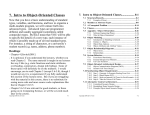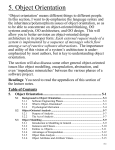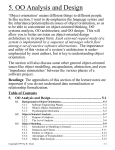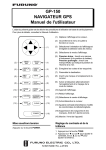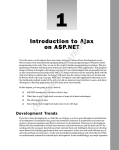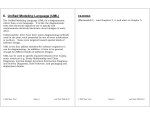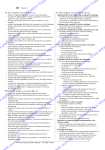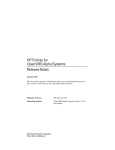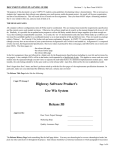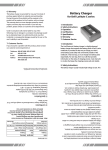Download 8. Intro to Object
Transcript
8. Intro to Object-Oriented Classes
8. Intro to Object-Oriented Classes................... 8-1
8.1 Structures............................................................................ 8-4
Now that you have a basic understanding of standard
types, variables, and functions, and how to organize a
multi-module program, we will venture forth into
advanced types. Advanced types are programmer
defined, and usually aggregate (sometimes called
composite) types. By this I mean that YOU will be
able to specify the details of a type, each instance of
which is possibly made up of several standard types.
For instance, a string of characters, or a university’s
student record (e.g. name, address, phone number).
Note that we will also investigate aggregate types
which contain aggregate types (e.g. a record that
contains name strings that contain characters).
There are 4 statements used to define new types in
C++: structure, class, typedef, and enumeration
statements. Also, there is the aggregation feature
called arrays. In this section we will look only at the
first two.
Readings: Chapters 6 and 8 of [Savitch99]
8.1.1
8.1.2
8.2
8.3
8.4
8.5
8.6
Example of Struct................................................................8-5
Composition Hierarchy .......................................................8-8
Intro to Object Orientation............................................. 8-10
Class == Type ................................................................... 8-14
Basic C++ Classes ............................................................ 8-15
Member Scope.................................................................. 8-18
Initializing Member Attributes....................................... 8-21
8.6.1
Intro To Constructors.........................................................8-23
8.7 Appendix - Object Orientation ....................................... 8-27
8.7.1
8.7.2
Software Engineering Phases ............................................8-27
What Is Object-Orientation? .............................................8-27
8.8 Object Modeling............................................................... 8-29
8.8.1
8.8.2
8.8.3
8.8.4
Introduction to Modeling in General.................................8-29
Entities vs. Objects ............................................................8-30
Object Data Analysis.........................................................8-31
Object Attributes and Attribute Values..............................8-32
8.9 Object Relationship Diagrams........................................ 8-33
8.9.1
8.9.2
Object Icons.......................................................................8-33
Relationships .....................................................................8-34
8.10 System Behavior............................................................... 8-35
8.10.1 Event-based Partitioning ...................................................8-35
8.10.2 External Design (User Manual).........................................8-36
8.10.3 Use Case Scenarios ...........................................................8-36
8.11 Object-Oriented Architectural Design........................... 8-38
8.11.1 Object Communication Diagrams (OCD).........................8-38
8.11.2 Scenario Call Trace Design ...............................................8-40
8.12 Synthesizing Object Requirements ................................ 8-42
8.12.1
8.12.2
8.12.3
8.12.4
Step 1 - Generate As Scenario-Starting Event List ...........8-42
Step 2 - Blank Master OCD ..............................................8-42
Step 3 - Make an Internal Call Trace for Each Scenario ...8-44
Step 4 - Take the Union of All Traces ...............................8-50
8.13 Alternative Control Architectures.................................. 8-52
8.13.1 Centralized Scenario Design .............................................8-53
Copyright 1998 by R. Tront
8-1
Copyright 1998 by R. Tront
8-2
8.13.2 Roundabout Route Scenario Design..................................8-56
8.13.3 Principle Object-based Scenario Design ...........................8-57
8.1 Structures
Structures are new types that are aggregates of the predefined types already built into C++. They are exactly
similar to Pascal RECORDs.
The nice thing about structures is that:
•
•
they can hold several disparate types of values in one
composite container (i.e. variable).
they can be assigned from one to another as a whole.
Though we have not studied ‘arrays’ yet, in C and C++
(and most other languages) arrays have neither of these
features. This is what makes structures, and their more
interesting brother, C++ ‘classes’ more interesting and
more easy to use.
Structures are the first step on the road of
encapsulation and abstraction: putting things together
that belong together, and be able to treat the composite
as a whole. Often a client programmer can treat
structures as a whole without needing or wanting to
know their internal details. Client programmers are
those who use composites types defined and
programmed by other programmers. (Do you really
need to know how istream cin works as long as it does
its job?)
Copyright 1998 by R. Tront
8-3
Copyright 1998 by R. Tront
8-4
8.1.1 Example of Struct
Here is how you declare a new, programmer-defined
structure type called AirPosition. You use the keyword
struct, create your own name for the type, and in
braces {} specify the list of elements you want in your
new type.
struct AirPosition{
float latitude;
float longitude;
long altitude;
};
<--need semicolon!
Note that we did not use the Pascal keyword TYPE or
the C/C++ keyword ‘typedef’ to define this new type.
The ‘struct’, ‘class’, and ‘enum’ keywords are
adequate to define new types of their respective
natures, without needing the C++ keyword ‘typedef’.
It is convention to name user defined types to begin
with an upper case letter. Some companies encourage
programmers to begin the names of all programmer
defined types with an upper case “T”. Either is fine in
Cmpt 101, but you will loose marks on assignments if
you mix the two styles. Adopt one convention.
In Pascal these would be called (record) ‘field names’.
In C++ they are called structure or class ‘data
members’ or ‘member attributes’.
For those unfamiliar with geographic position terms,
latitude is a measure of the angle north or south of the
equator. Let us assume the south pole has a latitude of
-90 degrees. Longitude is a measure of East-West
position relative to Greenwich, England. Though
generally places like Vancouver are considered to have
a longitude of 123 degrees West, let us assume this is
-123 degrees.
Here is how you can use a structure in C++.
AirPosition pos1, pos2;
pos1.latitude = -123.;
pos1.longitude = 49.5;
pos1.altitude = 35000;
pos2 = pos1;
cout << pos2.latitute << endl
<< pos2.longitude << endl
<< pos2.altitude << endl;
Note why data attributes have their own names. If a
structure contains two data attributes of the same type,
we have to have a name for each so that we can later
specify which one we may want to assign to or from.
That is all there is to it. You define as many instances
of AirPosition as you need. You use the so called ‘dot
operator’ to ‘reach’ into a structure to set or access the
individual record fields. Assignment of a whole
Copyright 1998 by R. Tront
Copyright 1998 by R. Tront
8-5
8-6
structure instance is possible because the three fields
are stored adjacent to one and other in RAM, and the
compiler just arranges to have the whole section of
RAM occupied by the source record instance copied to
pos2’s location.
One thing that doesn’t work is outputting a structure
instance as a whole:
cout << pos2;
// <--does not work!
This is because the compiler doesn’t know which of
the many possible ways you might like the output
presented:
•
•
•
•
-123 49.5 35000
-123, 49.5, 35000
(-123, 49.5, 35000)
-123 deg. longitude, 49.50000 deg. latitude, 35000 feet
There are 3 ways to handle this:
1) As shown above, specify the attributes separately in a
compound output statement.
2) Write a function like print(ostream, AirPosition) which
prints the second parameter to the stream specified by
the first.
3) Overload operator<<() to handle AirPositions. This will
be covered later in the course if time permits.
Copyright 1998 by R. Tront
8-7
8.1.2 Composition Hierarchy
In an air traffic control system, it is often important to
keep a record of a particular aircraft’s path by
indicating the start and ending position. So we could
define a new type called:
struct Path{
AirPosition startPosition;
AirPosition endPosition;
};
Path pathVariable;
pathVariable.startPosition.altitude
= 2000;
This illustrates that structures can be composed of
any data attribute types, even including those of
other programmer defined types! The dot operator is
just used several times. Note that the dot operator
works from left to right, so the last statement above can
be equivalently written:
(pathVariable.startPosition).altitude
Notice that the above example has introduced a
composition hierarchy. This is not to be confused
with what we will later call a class or inheritance
hierarchy. There are two kinds of hierarchy in objectoriented programming. Composition hierarchy is an
equally important hierarchy that has been around for a
Copyright 1998 by R. Tront
8-8
long time, even before object-orient programming. It
allows us to think of a car as body, wheels, and motor,
and not be bothered with the internal details/
components of a motor. They are abstracted and may
not be of interest. You can treat the major components
as whole. e.g.
AirPosition pos3;
pos3 = pathVariable.startPosition;
Notice that if I was not interested in the internal details
of variable startPosition (that possibly my teammate
had authored), I can still grab one (as an encapsulated
whole) and move it around in my job of dealing with
whole aircraft paths!
8.2 Intro to Object Orientation
Generally, most computers are doing nothing most of
the time. In fact, most programs are doing nothing
most of the time. Generally, they are waiting for input
from a person, disk, or network. When input comes, a
program makes sure that the user sees the appropriate
response. It does this generally by having the input
event detection part of the program make function calls
to functions in modules which will cause the user to
see the appropriate reaction. These functions may in
fact call other functions, etc.
This then is the way that you should think of designing
a program. Each external request made of a program
(from menu, or network, etc.) is implemented by a
sequence of function calls among a set of reactive
software components. The importance and utility of
this vision of a system’s architecture is underemphasized by most authors, but is key to
understanding object orientation.
The software components that export the functions that
give the appropriate reaction might be:
•
•
Copyright 1998 by R. Tront
8-9
simple modules like a trigonometric library with sin() and
cos() functions.
Microsoft ActiveX COM components or other dynamic
link library-like things (e.g. modules in a different address
space to which one can make remote procedure call).
Copyright 1998 by R. Tront
8-10
•
or object instances.
The trigonometric library reacts in exactly the same
way every time you call sin(PI). But more interesting
and complex components may be embodied by their
authors to react differently on weekends, or when
called for the ninth time since program start-up. So we
may regard these components as having:
•
•
intelligence because they can decide to react differently.
memory because they can remember things like how many
times previously they have been called, or the data
attributes of a structure they contain. (And can use that
data to help them with a decision).
In the C++ we have studied so far, we have seen how
to create types, variables, functions, and modules.
What most systems are made up of is nice cohesive
reactive modules. But when we have a module, we
have only one. This is unlike types which from which
we can create many variables. Wouldn’t it be nice to
be able to create multiple variables of a type that ‘has
some reactive ability and intelligence’? This would
allow us to create a program for say airplanes in an
airline, which operated by modeling the multiple
instances of airplane ‘objects’ in the real world. If
your airline had 50 airliners, you could define 50
airliner objects in a computer program designed to help
manage the physical airliners. And because they are
Copyright 1998 by R. Tront
8-11
reactive, you could ask (i.e. call) each one for its
position, its flight hours since last oil change, or to tell
it that it now has long range fuel tanks installed. Your
airplane management system is then designed around
these. Each command the management system
receives from its user is programmed to set off the
correct sequence of calls to the various modules and
object instances in the program.
What’s more, is that these objects model in a limited
way the real airliners. Real airliners have:
•
•
•
an ID,
other stored data, and
reactive abilities.
Humans naturally think of most things in the world as
objects of one sort (i.e. class) or another. And it helps
us to design computer programs, and to make less
mistakes doing so, if our design technique and
programming language supports this same paradigm.
In addition, it has been found that permitting
encapsulation of data and reactivity in an abstract way
allows us to build less brittle designs that are more
easily maintained. This is because objects tend to be
fundamental to a design. During future enhancement
of an airline application, you might need more than 50
airliners, or airliners with more attributes or more
Copyright 1998 by R. Tront
8-12
reactive functions, but you will always need airliners
components. Objects provide a sturdy foundation
around which to build your software design!
During future maintenance, you will unlikely have to
tear your airliner types apart, or merge two different
types of objects.
8.3 Class == Type
When we say the variable’s ‘type’, we are referring to
the type classification that the variable falls within.
Can it be classed as an short int, a float, or an
AirPosition. Please don’t get confused by the term
‘class’ in object-oriented programming. It is just a
programmer defined type, like a struct, but which
additionally contains reactive functions.
Because it is a type, we can create many variables of
that type. These are called instances of the type. So:
•
•
object class == type
object instance == variable
Unfortunately, many programmers use the word
‘object’ without clarifying whether they mean object
class or object type. Usually they mean object
instance, but not always. I will always try to be
specific, and if I slip, please stop me and ask me to
clarify which of these two case I mean.
We will now start looking at simple C++ class types.
But I have put in the appendix some extra, preliminary
reading on object-orientated analysis and a cool object
oriented design technique. It is important to read as
background, especially since I will likely require you
to draw a so called Object Communications Diagram
(OCD) for your next assignment.
Copyright 1998 by R. Tront
8-13
Copyright 1998 by R. Tront
8-14
8.4 Basic C++ Classes
AirPosition pos1, pos2;
A class in C++ is the same as a C struct, except that:
•
•
•
in addition to member attributes, it can have member
functions.
classes allow you to reduce the scope of the members with
particular keywords. In fact, the default scope is that
nothing is usable outside the class. This is a safe default,
but you usually have to add some public parts for
applications programmers.
actually, there are a lot of other interesting things, but
those are the essential features you need to know for the
moment.
Here is the AirPosition record turned into a C++ class:
pos1.latitude = -123.;
pos1.longitude = 49.5;
pos1.altitude = 35000;
pos2 = pos1;
cout << pos2.latitute << endl
<< pos2.longitude << endl
<< pos2.altitude << endl;
pos2.drop(1000);
cout << pos2.latitute << endl
<< pos2.longitude << endl
<< pos2.altitude << endl;
class AirPosition{
public:
float latitude;
float longitude;
long altitude;
void drop(int dropHeight){
altitude = altitude - dropHeight;
}
};
<--need semicolon!
Notice that this class has, in addition to member
attributes, also a member function! You use a class
very similarly to a C struct.
pos1.drop(2000);
Note that to specify which AirPosition variable (i.e.
object instance) that is to be dropped in each call, you
didn’t need to send in the variable (i.e. object instance)
as a parameter. Instead, you regard each variable as
having its own copy of the member function, and each
instance’s member function knows to drop the altitude
of its own data attribute.
Copyright 1998 by R. Tront
Copyright 1998 by R. Tront
8-15
In actual fact, there is not multiple copies of the
function as that would be terribly wasteful. Instead the
C++ compiler secretly passes the object instance by
reference into the function as a hidden zeroth
8-16
parameter (i.e. before the first parameters). On rare
occasions you may need to refer to the passed in
instance, so it is give the formal parameter name of
‘this’. As a result, I could have equivalently written
the body of the drop function as:
void drop(int dropHeight){
this.altitude =
this.altitude - dropHeight;
}
Read this on your own: Sometimes you will find your
own member functions hard to read (!) because they
have so many names in them, some of which are from
a long formal parameter list, and some of which are
member attributes but unfortunately have names
similar to the formal parameter names. Thus while
reading a particularly long complicated member
function you will get confused. If you add the
keyword ‘this’ followed by a dot to all the member
attributes in a member function, it will become much
clearer which names are member attributes and which
are formal parameters. This is rarely done as it clutters
up the code, but is a worthwhile thing to do if you are a
novice or are writing particularly complicated member
functions. If you have done this, don’t bother
removing them later as they will likely be helpful to all
readers of your code.
Copyright 1998 by R. Tront
8-17
8.5 Member Scope
First, generally a class creates a new name scope. The
attribute ‘altitude’ will not conflict with a similarly
named module variable which is defined in a module
which uses that class. This is because the module
programmer will always have to ‘qualify’ a reference
to the altitude member attribute with the instance
name. e.g.
pos1.altitude = 35000;
This is true for functions too.
Note that a class author needn’t bother with this
qualification, as he or she is programming within the
scope {} of the class.
Second, recall that you will have to have a split
personality in this course. As a class author, you may
not want other programmers who will use your class
definition to mess with certain internal details of your
class, lest you later need to change them. Then you
would have to find all the programmers who had used
your class in their program, and make them find and
change their code to comply with your changes.
To restrict them from messing with your code you can
declare certain members off limits. e.g.
Copyright 1998 by R. Tront
8-18
class AirPosition{
private:
float latitude;
float longitude;
long altitude;
public:
void drop(int dropHeight){
altitude = altitude - dropHeight;
}
};
Now application programmers cannot do the following
AirPosition pos1, pos2;
pos1.latitude = -123.;
pos1.longitude = 49.5;
pos1.altitude = 35000;
Note that the following are still usable by application
programmers:
pos2 = pos1;
pos2.drop(1000);
The first is usable because of encapsulation; you can
manipulate the class instances as a whole as long as
you don’t directly set/get/call their private members.
The second is usable because you can of course still
use public members (be they functions or attributes)!
cout << pos2.latitute << endl
They cannot set private member attributes, access
private member attributes (which is what the cout
statement needs to do). In addition, if there are any
member functions that are declared in the private
section, they too are unusable to an application
programmer too. They might be there as local helper
function for the class author. Note these private
members are visible (unfortunately) in the class
declaration, but they are not usable outside the class
(not even in the same module as the class declaration!).
Copyright 1998 by R. Tront
8-19
Copyright 1998 by R. Tront
8-20
She can do this because initialize is a public member
function, and even public member functions have
access to the class’s own private variables!
8.6 Initializing Member Attributes
Since the private members are not accessible, you
might ask how they get values.
If they were public, you could as shown in your text do:
AirPosition pos5 = {-123.,49.,28000};
But this doesn’t work if the attributes are private.
You could write and export a public member function
like:
Note that an initialization function, or a constructor (as
discussed next) can be used to initialize non-private
member functions. Such functions can also do useful
work other than just setting variables.
class AirPosition{
private:
float latitude;
float longitude;
long altitude;
public:
void initialize( float latParam,
float longParam,
long altParam){
latitude = latParam;
longitude = longParam;
altitude = altParam;
}
void drop(int dropHeight){
altitude = altitude - dropHeight;
}
};
A client programmer could then use:
Airposition pos6;
pos6.initialize(123.,49.,28000);
Copyright 1998 by R. Tront
8-21
Copyright 1998 by R. Tront
8-22
8.6.1 Intro To Constructors
Another way to initialize member attributes is to use a
‘constructor’. There are many different kinds of
constructors and we will look at them later. But let’s
look at a simple one.
A constructor is kind of like a function but you can’t
call it. It gets triggered by C++ when you create a new
variable of the object type. Two examples of when this
happens is when you use statements like:
AirPosition pos8(123., 49., 28000);
or
AirPosition pos8 = AirPosition(123.,
49., 28000);
The interesting things about adding a constructor to a
class are that:
•
•
•
their function name is the same as the class name,
there can be several all with the same name (as long as
they have different lengths or types in their parameter
lists),
they must be declared to return nothing, not even ‘void’!
See the constructor I have added in the class below:
The latter constructs an anonymously named instance
with the appropriate attribute values, assigns it to the
existing instance pos3, and then the anonymous one is
destroyed. This is wasteful so the former is preferred.
You might want to use the latter only when assigning
to a existing instance as in:
pos3 = AirPosition(123., 49., 28000);
Copyright 1998 by R. Tront
8-23
Copyright 1998 by R. Tront
8-24
class AirPosition{
private:
float latitude;
float longitude;
long altitude;
public:
AirPosition(float latParam,
float longParam,
long altParam){
latitude = latParam;
longitude = longParam;
altitude = altParam;
}
void initialize( float latParam,
float longParam,
long altParam){
latitude = latParam;
longitude = longParam;
altitude = altParam;
}
void drop(int dropHeight){
altitude = altitude - dropHeight;
}
};
You can see that this class definition is getting very
long. I will show you in future how to create a
declaration that just contains member function
prototypes rather than the whole function body’s
definitions. The definitions are put outside the
declaration’s braces {}, possibly even in a different file.
Copyright 1998 by R. Tront
8-25
Copyright 1998 by R. Tront
8-26
8.7 Appendix - Object Orientation
•
This rest of this set of lectures is an appendix
containing multiple subsections of an introduction to
object orientation, to object-oriented analysis (OOA),
and one very nice technique for object-oriented design
(OOD).
•
•
You can read this on your own.
8.7.1 Software Engineering Phases
Most projects have several phases. Software projects normally
have:
• An analysis phase to gather and record the requirements,
• A design phase to plan the architecture and implementation
strategies to be used, and
• An implementation phase where code is written.
• A quality assurance aspect. Final quality of the product is
assured by actions taken throughout the project. e.g.
To business system analysts it means determining and focusing
on the business entities (e.g. sales item, customer, invoice, etc.)
about which information must be processed or recorded. This
pre-dates object-oriented languages.
To a software designer, it is the architectural view that a system
satisfies each external command by the set of actions resulting
from the trace of calls or messages sent among various reactive
software objects to implement that request.
To a programmer, it usually means programming language
syntax that allows the programmer to easily:
- view data as having reactive abilities, and
- re-use code via inheritance hierarchies, and
- have both type flexibility and ease of maintenance via
polymorphism.
- requirements, design, and code reviews,
- unit and system testing, and
- appropriate configuration management.
Approximately 15% of projects fail or are cancelled, usually
because of failure to do some these aspects of the project properly.
8.7.2 What Is Object-Orientation?
Often there are specialists who work on each aspect of a large
project. Object orientation means something different to each of
them:
Copyright 1998 by R. Tront
8-27
Copyright 1998 by R. Tront
8-28
8.8 Object Modeling
•
8.8.1 Introduction to Modeling in General
•
A model is a representation of a actual thing. To a child, a model
is something created which is a ‘smaller’ but adequate likeness of
the real thing. To a car dealer, a model is a bunch of cars which
are near identical (cf. object ‘class’). In systems analysis, a model
captures the essential nature of something by indicating the
essential details that need to be stored about things of that ‘class’,
or by illustrating the flow of stuff required through a system, or by
specifying the sequential ordering (e.g. making paper in a pulp
mill, getting a university degree) within a process, etc.
we needn’t waste space storing useless information about the
thing,
we may write a program to implement a system which allows
humans to better administrate the processes in which the thing
participates.
8.8.2 Entities vs. Objects
Definition: A model is an alternate representation with an
‘adequate likeness’ of the real thing.
The data that a system needs to store is mainly computer records
of the instances of various record types in the application domain
(e.g. orders, customers). Traditionally in information systems
analysis, these things were called entities. Each entity class has a
record/structure type with a different layout of attribute fields.
Order instances have order ID number, part ID designator, and
quantity of order fields. Customer records have name, address,
and phone number record fields.
Some of the alternate representations we in systems design may
use for the actual things are:
• a diagram or picture
• a form or computer record
• a process description, data flow diagram, or finite state machine
More recently, is has instead become popular to call domain
entities objects. The term ‘objects’ has an additional implied
meaning that the model of the object we are documenting contains
data plus reactive abilities (i.e. plus ‘functions’, or ‘operations’,
‘behavior’, ‘ability to control things’, ‘intelligence’,
‘liveliness’(e.g. can be sent messages or ‘activated’)).
The purpose of creating a model is to represent only the essential
characteristics of the thing so that:
• we may understand and clearly document the nature of the thing,
• we may store the essence of the thing for later retrieval,
• we may communicate the nature of the thing to someone else,
• they can think and/or reason about the correctness of the model
without:
In fact, this idea is carried even further by OO languages. Rather
than procedures having data parameters, instead object data
is regarded as having operations/procedures that can be
triggered by a message. In fact, individual instance records (not
just ADT modules) are regarded as having procedures.
- being distracted by the complexities of the complete real thing
(i.e. abstraction)
- having to travel to where the real thing is located
- having to see the function of a real thing while it is operating very
fast
Copyright 1998 by R. Tront
8-29
e.g. Instead of (in C):
struct CustomerType custRecord;
printRec(custRecord, theFastPrinter);
You do this (in C++):
CustomerType custInstance;
custInstance.print(theFastPrinter);
Notice this is not like C, nor like Modula-2 where you would have
done ModuleName.print(). The symbolic name to the left of the
Copyright 1998 by R. Tront
8-30
dot is a variable name (i.e. instance), not a module or class/type
name. The procedure now appears to be a field of the instance, as
if the instance ‘has/owns’ its procedures!
8.8.3 Object Data Analysis
In object data analysis, we try to determine an organized way of
diagramming and storing information about the various relevant
object types involved in the application domain. To a new
analyst, sometimes it is not immediately apparent what kinds of
data might need to be modeled. Examples of the object classes
needed to be modeled within an application might be:
• a physical object (e.g. person, aircraft, robot, printer).
• an incident or transaction that needs to be recorded either for
immediate use, for transmission to someone else, or for a
historical log (e.g. order, purchase, sale, boarding an airplane,
graduation, marriage, phone call). Note a purchase is from the
purchaser’s application’s point of view, while a sale is from the
seller’s. Interactions between two other objects sometimes fall
in this category.
• a role (e.g. student, client, customer, manager, spouse).
• an intangible concept (e.g. bank account, time delay, date, sound
recording),
• a place (e.g. parking space, warehouse #3, the 13th floor heat
control),
• a relationship (e.g. customer’s sales representative, a flight’s
captain),
• a structure - e.g. the list of an airplane’s component part
numbers (body, wings, engines, tail), possibly even a hierarchy.
• an organization or organizational unit (e.g. university,
department, corporation, submarine crew, sports team).
• a displayable field (e.g. string, icon, image) or printed report, or
an I/O signal
Copyright 1998 by R. Tront
8-31
•
Specifications or procedures- e.g. organic compound or recipe.
8.8.4 Object Attributes and Attribute Values
We use the terms ‘object class’ to mean group of instances of
things which have the same set of attribute names (e.g. car’s each
have a licence number, color, and weight), but which have
different values for each of those characteristics (this is what
makes the instances of the same class different from each other).
It is common for a class of entity instances to be modeled as a
table of fixed length records:
STUDENT TABLE
student-id student-name student-address student-phone high-school
93010-1234
Smith, Bill
92010-4321 Jones, Jane
91111-1056
Able, Jim
123 Second St.
420-1234
Mt. Douglas
234 Third St.
123-4567
Burnaby
345 Fourth Rd.
822-9876
John Oliver
This concept is in keeping with the view that a student file is a list
of fixed length records.
Each column represents an attribute of the type ‘student’ (i.e. a
field of a student record). The legal set of values that an attribute
may take on is called the domain of the attribute. Examples are
date = (1..31), and day= (Sunday..Saturday).
Each row represents a particular instance of a student. Often the
rows are sorted in order by a particular column or columns. That
column(s) is called the primary key.
Copyright 1998 by R. Tront
8-32
8.9 Object Relationship Diagrams
8.9.2 Relationships
8.9.1 Object Icons
Object-Relationship Diagrams (ORDs) contain both entity classes
and the relationships between them. An example of a relationship
is that between a student and a high school.
Let’s examine an example of an Object Relationship Diagram
(ORD) carefully. The one below shows two objects.
STUDENT
STUDENT
HIGH-SCHOOL
* student-id
* high-school
Graduated
From
- student-name
- student-address
Graduated
* student-id
- student-name
- student-address
- school-address
- school-phone
HIGH-SCHOOL
R1
Graduated
Graduated
From
* high-school
- school-address
- school-phone
- student-phone
- high-school(R1)
- student-phone
- high-school
In is not clear whether they are object instances (since there titles
are singular) or entity classes (since only their attribute names and
not attribute values are shown). Normally in ORDs it is not really
important that you differentiate between whether the boxes are
classes or instances. You will probably find it best to think of
them as generic instances (not having had attribute values
assigned yet). i.e. they are an object storage/record layout plan.
Note that instead of having the attributes listed horizontally, as in
the column titles of a table, we have the attributes listed
vertically. This is widely done, though there is no reason for this
except it makes the entity icons have a smaller maximum
dimension. Also, note that the attribute(s) on which the records
are sorted are called the primary key of the entity, and are
labelled with a ‘*’.
Copyright 1998 by R. Tront
8-33
Fundamentally, relationships are illustrations of links between
entities. These links are simply (but importantly) the referential
routes that could be traversed by the application code to find other
related data. Note that the high school attribute in the student
class is a foreign key which provides the information needed to
traverse R1. A foreign key is a value- or pointer-based reference
to particular related instance (e.g. particular high school). Valuebased foreign keys refer to the primary key of the other related
(i.e. foreign) object.
ORDs provide a map showing all possible ‘routes’ over which
the application can navigate around the data. For instance,
given a student object, how does the application code find out the
phone number of the high school she went to? Answer: Look in
the High School attribute of that student to find out which high
school, then find that high school record in the high school
database, then look at the school-phone attribute in that record.
Copyright 1998 by R. Tront
8-34
8.10 System Behavior
Recent methodologies suggests that you start analysis by
determining an application’s data model first. Even for nondatabase projects, this identifies early the application domain
objects which will most likely form core software elements of
the eventual implementation. In particular, the names of the
important objects, their attributes, and their relationships are
researched. Once this is done, we are in a better position to plan
the implementation of the behavior of the system.
Previously, programs were regarded as a main module and
subprograms which implementing an application’s functionality.
The newer, more object-oriented view is that a system’s behavior
is simply made up of the sum of the behaviors of the object
classes and instances in the system. The objects collaborate
together during execution to get each user command done.
You can see why we had to identify the core object classes first,
as it is they what we now propose to embody with a behavioral
nature. But before we start writing code for the system’s objects,
we have to decide what behavior each will contribute to the
whole. The next question then, is what behavior does each object
class and instance need to export to the system, in order to that it
satisfy it’s behavioral responsibilities to the application? In the
next few sub-sections of the lectures, I plan to introduce a very
beautiful mechanism to synthesize the required behavior for each
object class and instance.
8.10.1 Event-based Partitioning
Modern applications are event-driven in nature. Think of your
personal computer; it idles for billions of instructions waiting for
an event like a mouse click or a clock tick.
With this view, we will design the system by looking at how each
external command or scenario-starting event is handled by the
system. By looking at each external command/event one at a
Copyright 1998 by R. Tront
8-35
time, we can reduce the scope of what we have to think about at
any point in the design process to handleable proportions. When
writing a requirements specification for a system, it is not
uncommon to first list or diagram all the sources of external
commands/events that the application must interact with (e.g.
keyboard, mouse, clock, network, printer, etc.). Then in more
detail, you should name/list each kind of event/command that the
application program is to handle from each source.
8.10.2 External Design (User Manual)
Before beginning architectural design, it is not uncommon to write
a draft user manual to firm up the behavior expected of the system
for each user command. This sounds weird to some people who
feel the manual is written after the coding is done. But those who
finish Cmpt 275 realize that:
• you can’t write the code until everyone on the team knows what
the program is supposed to ‘look like and behave like’!
• Often this look and behavior must be approved by someone else,
so rather than spending months first writing a program that is not
what the customer wants, you instead spend a week writing a
draft version of the user manual for customer pre-approval.
8.10.3 Use Case Scenarios
An individual command may have several steps that should be
documented in the draft manual. An example sequence might be
clicking a menu command, entering several pieces of data in a
dialog box, then clicking OK, the application checking and saving
the entered data (often different pieces in different objects), then
finally telling the user that the command is done and waiting for
the user to click OK again. This is called a use case scenario.
Later during architectural design, we must plan what part of
each step of a use case scenario will be handled by which
different object.
Copyright 1998 by R. Tront
8-36
We could thus define:
• ‘scenario appearance design’ to be deciding how a use case
would appear to a user (i.e. write the user manual), and
• ‘scenario call trace design’ (or ‘scenario implementation
design’) to be deciding the internal software architecture for a
use case.
8.11 Object-Oriented Architectural Design
Though there are many aspects to architectural design, we will
concentrate here on the design of internal call traces for the
scenarios. [Rumbaugh96] states “designing the message flows is
the main activity of the design phase of development”.
8.11.1 Object Communication Diagrams (OCD)
It has been common for many years to sketch a diagram indicating
which procedures, or more recently which modules, call/
communicate/interact with which others. This provides an
interaction context which provides further understanding and
documentation of the purpose, responsibilities, and dependencies
of a module (often one module depends on services provided by
another via exported procedures).
Very recently, we have started to diagram object (rather than
module) interactions, and thus named such diagrams Object
Communication Diagrams (OCDs) or Object Interaction
Diagrams. Typically, each object class in your ORD which is
reactive should be put in your OCD (note: some structures which
are simply data records are not reactive and needn’t show in the
OCD). Also, you may consider modules which are not objects
(e.g. the main program or other utility modules) to be reactive
objects. The primary consideration here is that we identify
islands of reactive ability/behavior/intelligence/data/control.
These islands (i.e. components), working together, implement the
behavior of system.
Note that such a diagram is not to show ‘relationships’, but instead
interactions. Two objects which have no data relationship could
potentially send messages (i.e. call) each other. So an OCD is a
somewhat orthogonal view of the objects in a system, and
provides a kind of 2nd dimension to their definition.
Copyright 1998 by R. Tront
8-37
Copyright 1998 by R. Tront
8-38
Though this looks like a call structure chart, in fact the rectangles
are to be regarded as components (i.e. modules or object classes)
which export several differently named functions!
Main
start_accepting
The main concept here is to regard and diagram the system as a
collection of interacting reactive objects. The arrows show
messages (e.g. procedure calls) from one object to another.
Receiving objects should be programmed to react appropriately to
each message which they receive.
Event Generator
(e.g. User Interface)
8.11.2 Scenario Call Trace Design
UC1()
init_A()
In order to determine each reactive component’s responsibilities
and the operations it must export, we will examine how each
module participates in each use case scenario. In order to reduce
the complexity of this design step, we do this one scenario at a
time.
UC2()
Senior Object A
full?()
In the movie industry, planning for a film segment to be shot is
often done on a ‘story board’. The sketches on this board provide
anticipated camera shots (angles, scenery, costumes) at various
moments through the progression of the scene. In essence, the
user manual provides sketches of what the application will look
like and do, at various points through each scenario. It is a story
board. Scenario call trace design will also be done using a kind of
story board. A visual plan and textural explanation of which
procedure calls will be made (and why) between which objects at
each point during the execution of the scenario.
enqueue()
init_B()
add()
init_C()
Object B
Object C
enqueue()
Note: We could also call this scenario message trace design,
because in the Smalltalk OO language, function calls are termed
‘sending a message’ to another object. Yet other names could be
scenario implementation design, scenario event trace design, or
scenario internal interaction design.
Copyright 1998 by R. Tront
8-39
Copyright 1998 by R. Tront
8-40
External events will be the primary driver in our design process.
More specifically, a scenario-starting external event is a special
kind of external event which initiates a sequence of interactions
between the user and the application which carries out a use case
scenario as described by the use manual. In menu-driven
applications, menu selection events start most use case scenarios.
The activation of a menu command results in the application
receiving a message from MS-Windows. The user interface
component of the application which handles these messages
subsequently makes procedure calls to other application objects
appropriate for the command, and these objects may in turn call
other objects or modules.
8.12 Synthesizing Object Requirements
This subsection looks at a beautiful, step-by-step process by which
the requirements for individual reactive components can be
obtained from the overall system requirements (as embodied in the
use cases).
8.12.1 Step 1 - Generate As Scenario-Starting Event List
From the user manual, generate a list of all scenario-starting
external events that are required to be handled by the application.
There could be dozens or hundreds in a big system.
8.12.2 Step 2 - Blank Master OCD
If the menu command starts a long dialog with the user to enter a
number of pieces of data (e.g. customer name, address, phone
number) one after the other, the calls may solicit other external
events associated with that scenario. These latter events are
termed ‘solicited’ as the application subsequently solicits specific
further input from the user as is needed to complete the
command. The application responds to each solicited event in the
appropriate way for that step of the scenario (e.g. read the data, do
something with it, prompt for the next entry).
An Object Communication Diagram is a diagram which shows the
objects from the ORD in a diagram without the relationships, and
shows additional reactive components such as main, UI, and
control modules. Generally, the objects are not placed in the same
position on the diagram page as they were in the ORD (where they
were arranged to make the relationships most tidy). Instead, place
the objects in a hierarchical manner radiating away from the
principle external event source (typically the user interface).
Copyright 1998 by R. Tront
Copyright 1998 by R. Tront
8-41
8-42
8.12.3 Step 3 - Make an Internal Call Trace for Each Scenario
Main
Make many copies of the blank OCD diagram, one for each
scenario-starting external event. For each scenario-starting event,
design a trace for the anticipated calls needed to implement the
proper response to that external event. (Some of the design issues
which impact the choice between different trace options are
discussed later). Document the trace on a single, blank OCD
page. (By confining ourselves to designing one scenario’s
implementation at a time, we need not be distracted by arrows
involved in other scenarios).
• The first scenario you should consider is the ‘program start’
event. This scenario should be designed to have the main
module send a tree of internal initialization events (i.e. calls) to
the key objects telling them to initialize (open their files, set
stack to empty, etc.). The principle of low coupling dictates that
the main module should not know the name of all the objects/
modules in the system, but only those directly below it. Those
mid-level objects in turn send initialization messages to their
subordinate objects. Any of these calls might create a number
of default RAM objects as necessary for the initial functioning
of the program. Once the system is initialized, the main tells the
external event source components (e.g. the user interface) that
they can start accepting external user events.
Event Generator
(e.g. User Interface)
Senior Object A
Object B
Copyright 1998 by R. Tront
Object C
8-43
Copyright 1998 by R. Tront
8-44
Start-up Implementation Call Trace
•
Main
Event Generator
4:start_accepting() (e.g. User Interface)
1: init_A()
Senior Object A
2: init_B()
Object B
Copyright 1998 by R. Tront
3: init_C()
Object C
8-45
Label each message/call with a number indicating it’s sequence
in the execution of that scenario, and with the name of the
procedure being called.
On another diagram, for the first external scenario-starting
event on your list, draw the trace of calls/messages that will be
sent from the external interface object receiving the starting
event to the principle reactive objects required to implement the
response to that event. This will, in turn, sometimes cause an
intermediate control/handler object to send one or more internal
messages on to one or more other objects. Give each internal
message a sequence number and a name which indicates what
procedure is being called (or what the purpose of the message
is).
Each time you do this, you must think of all the internal object
interactions that could take place in handling a particular
external event. For instance, to register a student in a course
offering, you must first check whether the course offering exists
before adding a record to the association object called studentregistration.
For each diagram, it is usually necessary to document in either a
paragraph, list of steps, or pseudo-code, a textural description of
how the scenario is planned to be implemented. e.g. “check
course exists and has space, then add student to course offering,
and update available remaining course space”. This provides
reviewers and subsequent implementation programmers with a
more understandable idea of how the scenario is to unfold.
Copyright 1998 by R. Tront
8-46
User Command #1 Implementation Call Trace
Main
User Command #2 Implementation Call Trace
Main
Event Generator
(e.g. User Interface)
Event Generator
(e.g. User Interface)
2:UC1()
2:UC2()
1:full?()
1:full?()
Senior Object A
Senior Object A
3:enqueue()
3:add()
Object B
Object C
Object B
Object C
4:enqueue()
•
On a yet another diagram (see next page), do the same for the
second user scenario-starting event on your list.
Copyright 1998 by R. Tront
8-47
Copyright 1998 by R. Tront
8-48
•
On a last diagram, show which module(s) can initiate program
shutdown, and the trace/tree of calls to the reactive components
which need to be informed of the upcoming shutdown. Such
components, upon being notified, shut files, flush buffers, reset
the video display mode (e.g. from MS-Windows graphic mode
back to DOS text mode, etc.), and delete themselves as
appropriate, before the main program ends. (I have not drawn
this trace to keep the resulting OCM simple).
8.12.4 Step 4 - Take the Union of All Traces
The result is the complete Object Communication Diagram:
Main
start_accepting
Event Generator
(e.g. User Interface)
UC1()
init_A()
UC2()
Senior Object A
full?()
init_B()
enqueue()
add()
init_C()
Object B
Object C
enqueue()
Copyright 1998 by R. Tront
8-49
Copyright 1998 by R. Tront
8-50
Notice in particular how two different scenarios both had calls to
the full() procedure of class Object_C. The (first) union
operation has merged these two into one arrow in the overall
OCD. All sequence numbers should be removed from the labelled
arrows since with so many different scenarios shown, they no
longer make sense.
The result is a fantastic diagram!
• The (first) union synthesizes an OCD from which the
requirements spec for an object class can be determined.
Obviously, the class must export a function for each different
type of arrow entering it. e.g.
•
•
The UI must export start_accepting().
Object A must export init(), UC1(), and UC2().
Object B must export init_B() and add().
Object C must provide/export empty(), enqueue(), init_C(), and
enqueue().
Notice that the above list seems to imply Object_C should
export enqueue() twice. By taking a second union, you can
merge the two different enqueue() calls to Object_C (which are
not merged by the first union because they are from different
callers), into one item in the list of procedures that Object_C
must export. Basically you must regard the list of exported
procedures as a true ‘set’ where duplicates are not allowed.
In addition, you get a requirements spec for each object’s
responsibilities to call/notify other modules/objects. An object
will do some internal processing when called, and then likely
some interaction with other objects. The diagram shows all the
other objects that a particular object is planned to get info or
processing from, or must notify in order to fulfill its
responsibilities. e.g. Senior Object_A has the responsibility to
notify those below it that they should initialize themselves.
Copyright 1998 by R. Tront
8-51
8.13 Alternative Control Architectures
The above strategy is very powerful as it constructively
synthesizes the requirements for individual modules and object
classes from an application’s external requirements. This makes it
an extremely appropriate technique to bridge the so called ‘design
gap’ that exists between the end of analysis and the beginning of
writing code for individual modules.
Please note that there are many alternatives in constructing the
trace of a scenario. This is where the real design decisions are
made. (The diagramming with a CASE tool and the double union
are basically just documenting the design decisions and
constructively gathering object specifications from the traces).
Trace alternatives will be discussed in the next section of the
course.
As with all design, there are usually several alternate ways to
design a sequence of internal call events that will carry out a
particular scenario. For example, when the UI receives an ‘exit
program’ command from the user, should it send messages to all
the objects telling them to shut down? Or should it call a
procedure in the main module which should then tell the objects to
shut down? ‘Design’ is choosing between workable
implementation alternatives to pick the one that is most
elegant, most easy to maintain, uses the least memory, and/or
is best performing.
Let us consider a simple reservation system. Generally a
reservation instance is for a particular flight, sailing, or video
rental instance, etc. A reservation typically is related to a
particular, say, sailing via a foreign key. When dealing with userentered data, we must use every effort to maintain referential
integrity of the database. Thus before creating a reservation
instance for a person on a sailing, we must check that that
Copyright 1998 by R. Tront
8-52
particular sailing actually exists. This scenario implementation
can be designed in one of three alternative ways. These three
ways will be shown in the next 3 sub-sub-sections.
event generator is programmed to simply call the correct scenario
orchestration function given the event that has just happened.
Event Generator (UI)
8.13.1 Centralized Scenario Design
1:UC5()
In this design, a particular reactive component which both is
informed when the scenario is to be initiated, and which
understands the scenario to be carried out, orchestrates the
execution of the scenario.
Central
2: checkExists()
Although often not the ideal design, this component may the event
generator itself (e.g. user or network interface module), in which
case application scenario code (possibly unfortunately) gets added
to the event generator module.
.
Event Generator (UI)
1: checkExists()
Sailing
Sailing
3: makeReserv()
Reservation
Scenario Description:
1) Prompt user for all info;
2) If Sailing exists
3) THEN make reservation
4) ELSE re-prompt user.
2: makeReserv()
Reservation
Alternatively, as shown below, an extra control module or object
can instead be added whose only job is to orchestrate scenarios. It
is not unusual for this module to export more than one function,
one in fact for each scenario to be orchestrated in an application
(or for a particular subset of scenarios in the application). The
Copyright 1998 by R. Tront
8-53
Copyright 1998 by R. Tront
8-54
In both the above centralized schemes, the controller sends a
message first to the sailing object to check that the sailing exists,
then waits for the return from that call, then makes a call to the
reservation object (supervisor/shepherd) to actually create the new
reservation, the waits for that call to return. The centralized
control scheme has the advantage of cohesively encapsulating in
one function of one module (be it the Event Generator or a special
component) the control and sequencing of internal calls needed to
carry out the processing needed in the scenario. Its advantage is
that if the control or sequencing of the scenario might later during
maintenance need change, only one function in one module needs
to be updated. Also notice that the sailing and reservation objects
do not communicate with each other, and thus don’t have to know
about each other (this is occasionally a good design feature). On
the other hand, the central object unfortunately gets coupled to all
the parameter types of all the lower calls.
Notice the explanatory text or pseudo-code that can be included
under a scenario trace diagram to more fully document the logic of
the scenario. This pseudo-code might, for instance, indicate
whether the sailing information needed from the user is read by
the sailing module or by the central control module.
This pseudo-code may or may not eventually be put into any
particular module. It may end up in the central module, or
alternatively be spread out over several modules if either of the
following designs is adopted. It is therefore not to be thought of
as programming, but instead as documentation of the scenario
logic from an architect’s point of view, so that programmers could
later implement the design properly as per the architect’s
specifications.
Copyright 1998 by R. Tront
8-55
8.13.2 Roundabout Route Scenario Design
The name of this section is a Tront’ism and is not widely used
terminology. The idea is that control is passed from the initiator
(i.e. event generator) to the first module which must supply
preliminary checking or data, and then that module forwards the
request to the final object. The control thus travels a rather
roundabout path to the terminal object. When the makeReserv()
procedure is done, it returns control to the Sailing, which in turn
returns from the makeResIfSailingExits() to the initiator.
Initiator
1:makeResIfSailingExists()
Sailing
2: makeReserv()
Reservation
Scenario Description:
1) Ask Sailing if it exists, and if so
2) THEN have it make reservation
3) ELSE have it return an exception to
the initiator which will then
re-prompt the user.
This design strategy is particularly good if using asynchronous
one-way messages, rather than procedures calls, as it requires no
data to be returned to callers.
Copyright 1998 by R. Tront
8-56
8.13.3 Principle Object-based Scenario Design
This design alternative has the initiator first informing the
principle application object involved, in our case the reservation
object. After that, the principle object (which may understand its
creation needs best) does whatever is necessary to accomplish the
request. In the example below, the reservation checks the sailing
exists, waits for the reply, then if ok makes a new instance of its
type, and then finally returns control to the initiator object.
Initiator
1: makeReserv()
2: checkExists()
Sailing
Reservation
Scenario Description:
1) Ask reservation to make an instance
2) It checks if Sailing exist.
If so reservation makes an instance,
3) ELSE return exception to initiator.
Note that these diagrams do not show the procedure returns, but
this design requires an OK to be returned to the reservation via a
parameter/return value. Either that, or if using one way messages,
a return message would have to be added to the trace.
Copyright 1998 by R. Tront
8-57





























